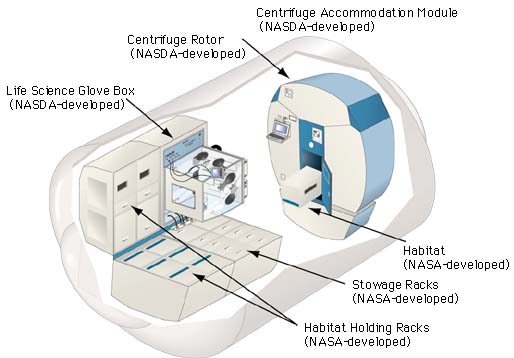|
|||||

In the International Space Station (ISS), various countries are pooling their knowledge to conduct a wide variety of research for the future benefit of the human race. Presently, each country is constructing various experiment systems. One of the core life science experiment systems being developed for the ISS is the Centrifuge (see note 1). The Centrifuge is used to scientifically determine the effects of a zero gravity environment on living things. It is composed of three elements, the Life Science Glove-box (LSG), the Centrifuge Rotor (CR), and the Centrifuge Accommodation Module (CAM). The LSG is used to conduct experimental procedures with biological specimens, the CR is used to generate artificial gravity, and these two components are mounted in the CAM. Japan is now developing the Centrifuge to off-set NASA's costs of launching the Japanese Experiment Module, Kibo, by NASA's space shuttle. 
LSG Design To Be Verified In Actual Zero Gravity Conditions
LSG is a unique bioisolated system for conducting zerogravity experimental procedures and will be installed in the Centrifuge. The Centrifuge is currently being developed in a cooperative project between NASDA and NASA (Fig.1). LSG will be used for a variety of activities, including animal surgery and observing the results with a microscope, administering medications, and to manipulate, observe, and process specimens and samples. When the specimens arrive in orbit and the experiments begin, the LSG will be a very critical science gathering tool at which the astronauts will spend a great deal of time. Numerous life science experiments have already been conducted aboard the space shuttle using space designed gloveboxes. However, many of the astronauts conducting the experiments experienced tiring of their arms and shoulders. Based on this, concerns were raised that the previously used glovebox was not suitable for the postures of astronauts working for extended periods in zero gravity. Working postures of astronauts in space differ from those on the ground. In space, astronauts assume a posture similar to that obtained by relaxing and floating under water. For that reason, the position of the gloves and angle of the observation windows becomes critical to prevent the astronauts' bodies from being subjected to an unnecessary discomfort. Computer simulations of early LSG design concepts were used to ensure that the LSG conformed to the natural postures assumed by astronauts in zero gravity. However, it is impossible to fully verify these concepts through experiments on Earth. To verify that the LSG can actually be used by astronauts in zero gravity, experiments were conducted with a mockup of the LSG design flown aboard an aircraft simulating the microgravity conditions of space. 120 Times of Microgravity Experiments
In Japan, aircraft microgravity experiment opportunities are provided by Nagoya-based Diamond Air Services. However, since this is a cooperative project between NASDA and NASA, the LSG experiments were conducted aboard NASA's KC-135 aircraft. The KC-135 is similar to a commercial Boeing 707 but has been modified to provide short periods of the zerogravity space experiments. An actual scale model of the LSG was flown aboard the KC-135 for the experiments. The experiments were conducted from June 8 to 10, 1999 from Ellington Field which is adjacent to NASA's Johnson Space Center. Astronauts themselves practice take-offs and landings in their T-38 jet aircraft at the same Ellington Field. As shown in Fig.2, the KC-135 follows a parabolic flight path for 70 seconds to achieve 20 to 30 seconds of simulated microgravity at the top of the parabola. Unfortunately, the microgravity period is short, and before and after the microgravity period, the airplane is subjected to 1.8 G forces at the bottom of the parabola. About 40 parabolic flights were flown on each of the three days, totaling 120 microgravity flights. Each KC-135 flight lasted about two hours from take-off to landing. Of those who experience microgavity for the first time, some are sickened by the "roller coaster"effect of the parabolic flight. This has resulted in the KC-135 being dubbed the "Vomit Comet." Human-Friendly Design Achieved
The results were quite successful. Furthermore, it was verified that the LSG would not impose burdens on the astronauts performing microgravity experiments and that a human-friendly design had been achieved. This experiment was conducted through the cooperation of numerous organizations. These included, the National Space Development Agency of Japan, Ishikawajima-Harima Heavy Industries, the University of California, NASA Ames Research Center, and NASA Johnson Space Center. Looking towards the future era of international cooperation, this experiment in which Japanese and American researchers and engineers combined their efforts and worked together was a truly valuable experience. Notes 1. Experimental facility for studying the influence of microgravity on living things aboard the ISS. 2. Devices for stabilizing astronauts' postures in a microgravity environment. Last Updated : March 21, 1999
|

|